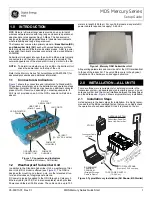
CMT2157AW
Rev 0.8 | Page 17/31
www.hoperf.com
Table 11. Main Timing Spec in Different Working States
Parameter
Symbol
Min
Typ
Max
Unit
XTAL Startup Time
[1]
t
XTAL
400
us
Time to Tune to Desired Frequency
[2]
t
TUNE
370
us
Notes:
[1]. This parameter is to a large degree crystal dependent.
[2]. From XO stable to ready to transmit.
5.7 The Encoder
The device supports 3 types of encoding formats: 1920, 1527 and 2262. The packets of these 3 modes have different
structures which will be introduced in the below sub-sections. The table below summarizes the major features of the 3
encoding formats.
Table 12. Feature Summary of the 3 Encoding Formats
Format
Bit Format
(sym/bit)
Sync ID Length
(bits)
Data Length
(bits)
CRC
ID Study
Button Modes
[1]
1920
3/4/5/6
1 – 32
1 – 7
Support
Support
All
1527
4
20
1 – 7
NA
Support
All
2262
8
6 – 11
1 – 6
NA
Not Support
Normal Mode
Note:
[1]. Button Modes include Normal Mode, Matrix Mode, Toggle Mode and PWM Mode.
All the details of these 3 types of encoding formats are given in the document “AN142 CMT2157A Configuration Guideline”. The
following sections only give the abstracts of these formats. In the below explanations, some elements in the packet are measured
in the unit of “symbol”, while some of them are measured in the unit of “bit”. For those which have the unit of “bit”, one “bit” is
constructed (encoded) by several “symbols”. In the figures, “SYM” represents the word “symbol”.
5.7.1 1920 Packet Structure
Two types of packet structures are supported for 1920 format: Normal Packet and Study Packet. The following configurable
parameters are shared by the two structures.
Table 13. Configurable Parameters in 1920 Packet
Parameter
Descriptions
Default
Mode
Preamble
The size of the valid preamble, the options are: None or
16-symbol.
None
Basic
Advanced
Address (Sync ID)
Length
The range of the Sync ID Length is from 1 to 32 bits.
32-bit
Basic
Advanced
Address (Sync ID)
Value
The value of the Sync ID has the range from 0 to 2
Length
-1.
0
Basic
Advanced
Normal Packet
The normal packet is used to control the data pins of the CMOSTEK receiver CMT2250AW or PWM output of the
CMT2251AW. It contains a 16-symbol Preamble, a 32-symbol Head_N (which indicates that the current packet is a normal
packet rather than a study packet), a Sync ID, a Configurable Data Field and an 8-symbol CRC.















































